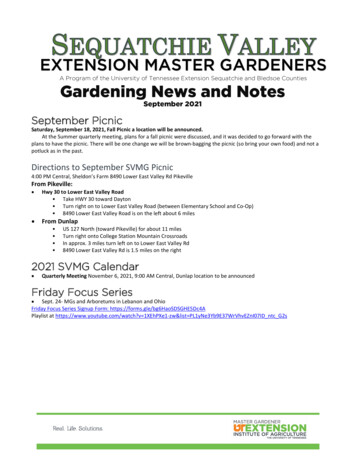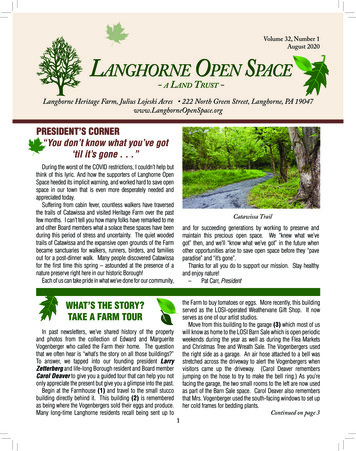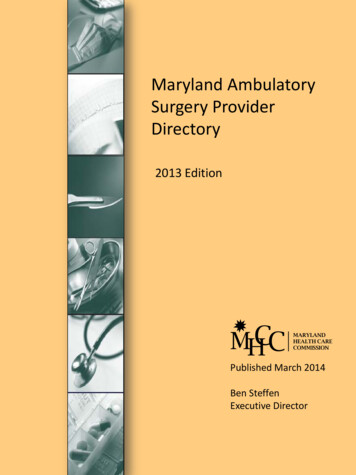
Transcription
Texas Master GardenersAugust 2019Volume 11, Issue VIIIGrimes CountyMaster GardenersGarden Tips for AugustWell, here it is .hot, dry summer. Its maintenance time to keep all those plants thriving and adequately watered. Here are a few August gardening tips:Inside this issue:Growing Succulents2Types of Succulents3Building an Insect Hotel4Events Calendar5Grimes County MasterGardeners6Cacti aresucculents butnot all succulentsare cacti Heirloom and hybrid roses have stopped blooming in the hottest time of the summer but now is the time to prune back about 25% to generate new growth forblooms in the fall. If your water source contains large amounts of salts then now is a good time todissolve and flush out your containers and plant beds by watering twice as longand deep. In dry conditions, salts will accumulate in the soil and cause poor performance. If you keep a garden journal, now is a good time to walk around your garden andcheck to see which flowers are blooming. Only the toughest can keep going thistime of year. Take a look at the graph below to find which vegetables can be planted in our areanow for a fall garden. Remember, most tomatoes take about 90 days to set fruit.Ninety days from August 1st is November 1st. The likelihood of frost in early November is slim but it has happened in the past.
Page 2Grimes County Master GardenersVolume 11,Issue VIIIGrowing SucculentsAre you a beginner gardener or just looking for something easy to grow?Then look no further than the succulent. Succulents are one of the easiestplants to grow, will take neglect and poor soil conditions plus they come ina large variety of colors and shapes. This diversity and ease of care lenditself to the current decorating trend with succulents whether it is buildinga living wall, creating a living wreath for your front door or even a succulentball to hang in a tree. The possibilities with these fun plants are enormousin addition to making great in-door additions to your home.The succulent plant comes from the dry, arid regions of Africa. Approximately 60 different plant families contain succulents. The Latin word“sucus” means juice or sap, which refers to the succulent leaves which arethick and full of water. This ability to hold water in their leaves helps the plants survive during dry weather conditions. Another attractive quality of succulents is that they can easily be propagated from just a cutting.Succulents like a lot of sunshine - at least 6 hours a day. However, during the hottest time of the summer where dailytemperatures reach above 90 degrees, a little shade protection goes a long way. Morning sunlight with protectionfrom the hot afternoon sun is recommended.Overwatering will cause succulents to develop root rot and die. A good rule of thumb is to only water when you feelthat the soil is dry an inch down or deeper. Thoroughly water and then let dry out completely between each watering. Make sure you have good soil drainage.Succulents cannot take freezing weather conditions, but they can easily be dug up and moved indoors for the winter.There are also many available indoor planters and pots that are specially made to show off your succulent collection.Best Succulents for Outdoors:Best Succulents for Indoors: Aeonium Rosettes Burros Tail Agave Hens and Chicks Aloe Vera Jade Plant Sedum Snake Plant
Grimes County Master GardenersTypes of SucculentsVolume 11,Issue VIIIPage 3
Page 4Grimes County Master GardenersVolume 11,Issue VIIIBuilding an Insect HotelParts of an Insect TowerBug HotelsInsect TowerOne of the tenets of Earthkind landscaping is to useless pesticides and promote a healthy and balanced ecosystem in yourgarden and yard. One wayto promote a healthy environment is to encourageand increase beneficialinsects like Green Lacewings, Lady Bugs, AssassinBugs, Solitary Native Beesand Parasitic Wasps. Youcan do this by orderingmore bugs and larva. Or,you can build a safe habitat for these insects. Thiscan be a fun, family projectthat you can do with children to teach them moreabout insects and theirhabitats.Insect hotels, as they arecalled, come in a variety ofshapes and sizes. Theirpurpose in winter is to provide a place for insects tohibernate. This providesnew insects at the start ofspring ready to forage inyour garden. In the summer an insect hotel is anice dry nesting placeaway from harsh weather.The great beauty of building an insect hotel is thatyou can use whatever materials you have on handand your imagination.Finding the perfect hotellocation depends on whattype of insect you want toattract. For instance, beesneed plenty of sunlightwhile other insects need tobe protected from rain orwet weather. It is a goodidea to research which insects you want to attractand read up on their natural habitat before buildingyour insect hotel.Placing your insect hotelnear a water source suchas a pond will provide optimum availability to insects.Or putting an insect hotelin the midst of your flowergarden will provide moreavailability for foraging.Here are some guidelineson what materials to useand why. The top photograph is numbered foreach section:1. Straw and wood: thisis good sheltering material for the lacewingswhose larva feed onaphids, thripes andwhiteflies.2. Bamboo rods: theseprovide shelter for mason bees.3. Flower pots filled withhay: attracts earwigswho eat on aphids.4. Wooden boards wherexylophagous insects(insects whose dietmostly consists ofwood) are involved indead wood.5. Pierced logs: thismakes a very goodshelter for many pollinators like solitarybees or wasps whoselarva feed on aphids.6. Bundles of bramble orrose rods: Anotherattractant for bees,wasps and sawflies.7. Bricks: again used bythe mason bee whichare solitary.8. Small boards: theyattract ladybugs duringthe winter. Their larvaconsume a lot ofaphids.Building an insect hotel is agreat family project. Theyare easy to make and helpyour garden and the natural world. You can makeyour insect hotel with anything you have on hand.There’s no right way orwrong way to make one. Ifyou search the internetyou will find hundreds ofideas on insect hotels.
Grimes County Master GardenersSchedule ofEvents Page 5Issue VIIIAugust 2019SunMonTueWedThuFriSat123Aug 10: MontgomeryCounty Master Gardeners: “DIY: Composting &Enriching Soil”; This presentation will identify the benefitsof compost, outline the steps tocreating compost, and explainways to use compost to a garden and a lawn; 8:00 a.m.Start. 7:30 Registration.Fee: 5; Thomas LeRoyEducation Building, 9020Airport Road, Conroe Volume 11,Aug 10: 2728293031County Master Gardeners: “Honing in on YourFall Vegetable Bounty”;Presentation includes propertime to plant and harvest, howto control diseases and insects,adequate soil moisture, croprotation and recommendedvarieties for spring gardens inthis area. 10:00 a.m. Fee: 5; Thomas LeRoy Education Building, 9020 AirportRoad, Conroe Aug 13: Grimes CountyMaster Gardeners:“Monthly Business Meeting”;9:00 a.m.—11:00 a.m.; CourtAnnex Building,NavasotaHave you thought about .Have you ever thought about becoming a Texas Master Naturalist? To become a Texas Master Naturalist, trainees must take a basic course that provides a background in all aspects of the natural history of Texas, with a concentration on the local area.For 2019, the New Member Training for the Texas Master Naturalist Brazos Valley Chapter willtake place Tuesday evenings from 3 September to 19 November 2019 from 6:00 to 9:00 pm,with five field experiences on Saturday mornings from 9:00 am to 12:00 pmClass Location: Brazos Valley Museum of Natural History in the Brazos Center, Bryan , TexasClass Fee: 160For details, go to https://txmn.org/brazos/welcomeFor questions about the class, please email the New Member Training Chair, Bruce Neville at education@txmnbv.org. For questions about registration, please email the Membership Chair, BettyVermeire at membership@txmnbv.org.
Texas Master Gardeners203 Veterans Memorial DriveNavasota, Texas 77868Website: txmg.org/grimesGrimes County Master GardenersPlease send submissions and photos by the20th of each month to: pwparmley@gmail.com2019 Board of DirectorsPresident . Cathey HardemanVice President . Sharon MurrySecretary . Paula ParmleyTreasurer . Dia Copeland2019 Committees/ChairsSedum SucculentAdministration . Herb AbrahamAdvertising/Publicity. Peggy SloanAuditing . Stephanie Cunningham/Jena JacksonCommunications . Georgia AbrahamCommunity Garden . Cathey Hardeman, Jamie Bruns, Paula ParmleyCo-op. Fred VespermanFacebook. Jamie BrunsFair Judging . Marti LuedtkeFundraising . Carol GarnetHistorian . Sharon MurryMaster Gardener Class Coordination. Herb AbrahamNewsletter. Paula ParmleyNominating . Carol GarnetSocial Awards . Connie ArdenTimekeeping . Martha Brogdon
of compost, outline the steps to creating compost, and explain ways to use compost to a gar-den and a lawn; 8:00 a.m. Start. 7:30 Registration. Fee: 5; Thomas LeRoy Education Building, 9020 Airport Road, Conroe Aug 10: Montgomery County Master Garden-ers: "Honing in on Your Fall Vegetable Bounty"; Presentation includes proper










